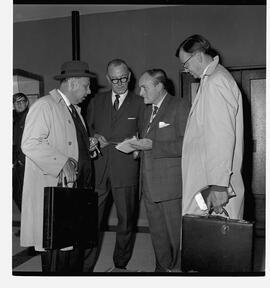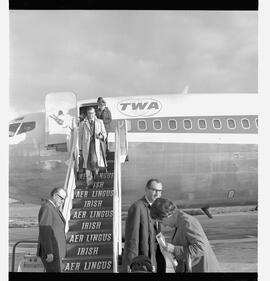Typescript draft of a script, A Broken Song, for sound-film scenario with information regarding cast, and begins: ‘Scenes: 1. A beer-garden in Munich on a summer evening.’ Title page contains sticker which reads ‘Mary Henderson from Elizabeth Marbury International Authors’ Agent 234 West 44th Street New York Room 702’. The script is contained in folder which has the following title: ‘A Broken Song Sound-Film Scenario by Kate O’Brien 37 Gordon Sq. London W.C.1’. Paginated.
O'Brien, Kate (1897-1974), writerBlack and white negative spares of the United States Secretary to the Solomon Islands on the ramp at Shannon Airport.
Shannon DevelopmentBlack and white negative of the United States Secretary to the Solomon Islands inside the Shannon Airport Terminal Building.
Shannon DevelopmentThis sub-series contains correspondence from Pearn, Pollinger & Higham Limited.
O'Brien, Kate (1897-1974), writerTwo letters from Y. Muller, secretary to Mr. Laurence Pollinger, of Pearn, Pollinger & Higham, Literary, Film and Dramatic Agents, of 39-40 Bedford Street, Strand, London, W.C. 2, to Kate O’Brien, care of Miss E. M. Deladield, Croyle, Cullompton, Devon, referring to Spanish translation rights of The Last of Summer and The Anteroom and an enquiry from Alfred Scherz of Switzerland for copies of O’Brien’s novels free for translation into Italian. The first letter includes comment ‘Messrs. Saturnino Calleja offers for the Spanish translation rights of The Last of Summer and The Anteroom the same terms as for Without My Cloak, namely: A sum of £75 payable as to half upon signature of the agreement by both parties, and half on publication for an edition of 5,000 copies and a sum of £20 payable upon printing of each subsequent edition of 1,000 copies’.
O'Brien, Kate (1897-1974), writerThis sub-series contains a letter from Fernando Calleja to Kate O’Brien.
O'Brien, Kate (1897-1974), writerLetter from Calleja, Ediciones ‘La Nave’, Madrid, to Kate O’Brien, having secured the Spanish world rights for three novels, Without My Cloak, The Ante-room, and The Last of Summer, and expressing interest in other works. He requests a number of items for publicity including a photograph of O’Brien, relevant press cuttings, and a short letter about her work. He notes, ‘I was enormously struck by “Without My Cloak”. I liked your lovely novel so much that I was loth to entrust its translation to anybody for fear they might not give enough attention to its many beauties, and although very short of time, I decided in consequence to translate it myself. I daresay better translators could be found but I am positive that nobody could give to the translation as much loving care. This is one of the most pleasant jobs that have come my way for a good many years.’
O'Brien, Kate (1897-1974), writerThis sub-series contains receipts and invoices from publishers.
O'Brien, Kate (1897-1974), writerMainly receipts including one from Samuel French Limited, Publishers, for copy of The Distinguished Villa and postage, sent to Vivian H.S. Mercier, a royalty invoice from Cedric Chivers Limited, Publishers, Booksellers, Bookbinders, Portway, Bath, BA1 3NF, addressed to David Higham Associates Limited, 5-8 Lower John Street, Golden Square, London, W1R 4HA, listing titles, number of copies sold, price, total sale and royalties, and a receipt from the Irish Times Limited addressed to Kate O’Brien, The Street, Boughton, Faversham, Kent, for sum of £21 for review. In addition, includes cheque for £20 from E.A. Hopkinson.
O'Brien, Kate (1897-1974), writerThis sub-series contains Kate O'Brien's correspondence with the British Broadcasting Corporation.
O'Brien, Kate (1897-1974), writer
